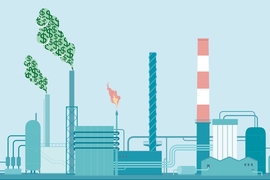India’s economy is booming, driving up electric power consumption to unprecedented levels. The nation’s installed electricity capacity, which increased fivefold in the past three decades, is expected to triple over the next 20 years. At the same time, India has committed to limiting its carbon dioxide emissions growth; its Paris Agreement climate pledge is to decrease its carbon dioxide emissions intensity of GDP (CO2 emissions per unit of GDP) by 33 to 35 percent by 2030 from 2005 levels, and to boost carbon-free power to about 40 percent of installed capacity in 2030.
Can India reach its climate targets without adversely impacting its rate of economic growth — now estimated at 7 percent annually — and what policy strategy would be most effective in achieving that goal?
To address these questions, researchers from the MIT Joint Program on the Science and Policy of Global Change developed an economy-wide model of India with energy-sector detail, and applied it to simulate the achievement of each component of the nation’s Paris pledge. Representing the emissions intensity target with an economy-wide carbon price and the installed capacity target with a Renewable Portfolio Standard (RPS), they assessed the economic implications of three policy scenarios — carbon pricing, an RPS, and a combination of carbon pricing with an RPS. Their findings appear in the journal Climate Change Economics.
As a starting point, the researchers determined that imposing an economy-wide emissions reduction policy alone to meet the target emissions intensity, simulated through a carbon price, would result in the lowest cost to India’s economy. This approach would lead to emissions reductions not only in the electric power sector but throughout the economy. By contrast, they found that an RPS, which would enforce a minimum level of currently more expensive carbon-free electricity, would have the highest per-ton cost — more than 10 times higher than the economy-wide CO2 intensity policy.
“In our modeling framework, allowing emissions reduction across all sectors of the economy through an economy-wide carbon price ensures that the least-cost pathways for reducing emissions are observed,” says Arun Singh, lead author of the study. “This is constrained when electricity sector-specific targets are introduced. If renewable electricity costs are higher than the average cost of electricity, a higher share of renewables in the electricity mix makes electricity costlier, and the impacts of higher electricity prices reverberate across the economy.” A former research assistant at the MIT joint program and graduate student at the MIT Institute for Data, Systems and Society’s Technology and Policy Program, Singh now serves as an energy specialist consultant at the World Bank.
Combining an economy-wide carbon price with an RPS would, however, bring the price per ton of CO2 down from $23.38/tCO2 (in 2011 U.S. dollars) under a standalone carbon-pricing policy to a far more politically viable $6.17/tCO2 when an RPS is added. If wind and solar costs decline significantly, the cost to the economy would decrease considerably; at the lowest wind and solar cost levels simulated, the model projects that economic losses under a carbon price with RPS would be only slightly higher than those under a standalone carbon price. Thus, declining wind and solar costs could enable India to set more ambitious climate policies in future years without significantly impeding economic growth.
“Globally, it has been politically impossible to introduce CO2 prices high enough to mitigate climate change in line with the Paris Agreement goals,” says Valerie Karplus, co-author and assistant professor at the MIT Sloan School of Management. “Combining pricing approaches with technology-specific policies may be important in India, as they have elsewhere, for the politics to work.”
Developed by Singh in collaboration with his master’s thesis advisors at MIT (Karplus, and MIT Joint Program Principal Research Scientist Niven Winchester, who also co-authored the study), the economy-wide model of India enables researchers to gauge the cost-effectiveness and efficiency of different technology and policy choices designed to transition the country to a low-carbon energy system.
“The study provides important insights about the costs of different policies, which are relevant to nations that have pledged emission targets under the Paris Agreement but have not yet developed polices to meet those targets,” says Winchester, who is also a senior fellow at Motu Economic and Public Policy Research.
The study was supported by the MIT Tata Center for Technology and Design, the Energy Information Administration of the U.S. Department of Energy, and the MIT Joint Program.









